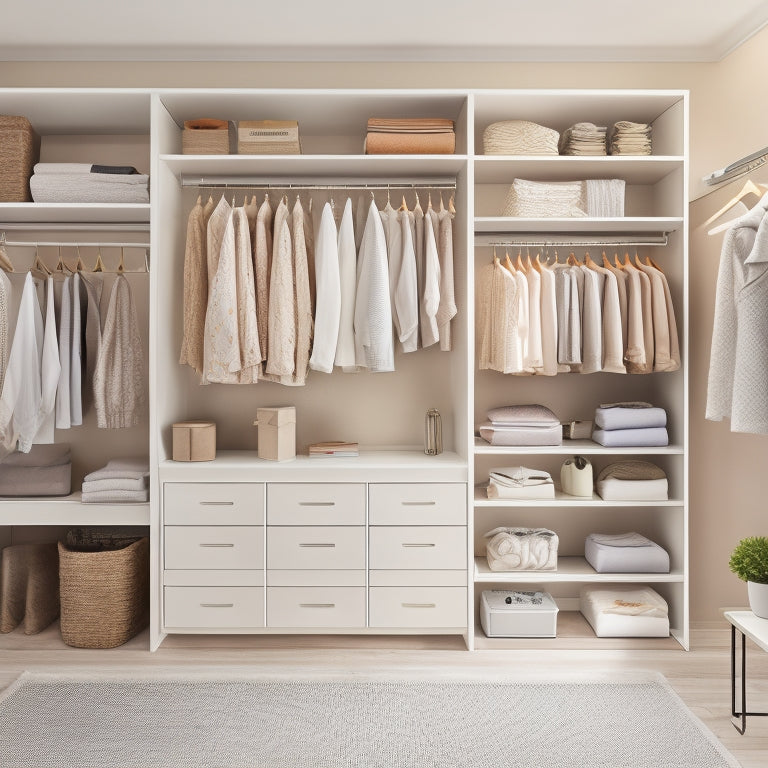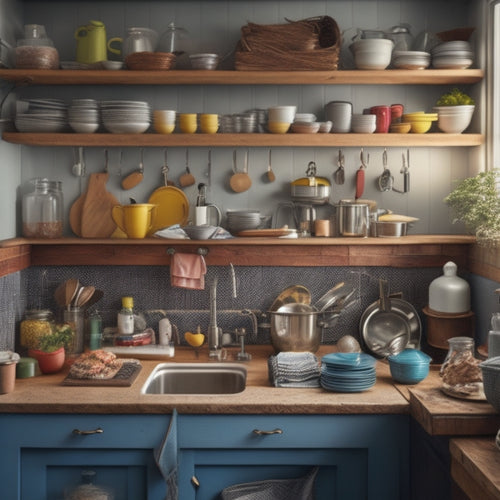
Closet Planning and Layout Made Easy
Share
You're on a mission to transform your closet into a peaceful retreat, and it all starts with a solid plan and layout. Begin by measuring your space accurately and using virtual planning tools to envision your ideal design. Choose a layout that maximizes storage and functionality, and don't forget to take into account lighting and color schemes that reflect your personal style. Next, add shelves, rods, and storage solutions that cater to your needs, and customize with accessories and hardware that bring your space to life. With these steps, you'll be well on your way to creating a closet oasis that's both beautiful and functional – and there's more to explore.
Key Takeaways
• Utilize measuring tapes and spatial arrangement skills to create an optimal closet layout that reflects personal style and maximizes storage.
• Leverage virtual planning tools to envision and experiment with different design scenarios, reducing the need for physical trial and error.
• Take precise measurements of closet dimensions to identify ideal placement for shelves, rods, and storage solutions, optimizing corner spaces and floor allocation.
• Choose a closet layout that caters to specific needs, such as double rods, designated shoe areas, and shelves for folded items, ensuring functional organization.
• Add finishing touches with accessories and hardware, selecting materials and styles that complement the overall design and enhance the aesthetic appeal.
Closet Design and Organization Tools
What do you need to get started on designing and organizing your closet - a plethora of measuring tapes, a keen eye for spatial arrangement, or a magic wand that makes clutter disappear? While a magic wand would be nice, it's not necessary.
You can create a functional and stylish closet with the right tools. Start by considering color coordination. Choose a palette that reflects your personal style and complements your clothing and accessories. This will help you create a cohesive look and make your closet feel more spacious.
Next, think about storage options. You'll need shelves, drawers, and rods that maximize your closet's space. Consider double rods, stackable shelves, and bins or baskets to keep items off the floor.
Don't forget about lighting solutions. Proper lighting can make a big difference in the ambiance and functionality of your closet. Install shelves with built-in lights or add floor lamps to create a warm and inviting space.
Simplifying Space With Virtual Planning
When you're planning your closet's layout, envisioning the space is crucial before making any purchases or installations.
With virtual planning, you can easily create a digital representation of your closet, enabling you to see how various designs and layouts will appear before committing to them.
Virtual Room Visualization
With virtual room visualization, you can easily experiment with different closet layouts and design scenarios before making any physical changes. This powerful tool allows you to test out various design inspirations and see how they'd look in your space without lifting a finger.
You can explore different 3D visualization options to get a realistic sense of how your closet will look and function.
Imagine being able to:
- Swap out furniture pieces to find the perfect configuration
- Try out bold color schemes and see how they impact the overall aesthetic
- Move walls and adjust shelving to optimize storage and flow
- Visualize the final result from multiple angles, ensuring it meets your needs and style
Designing Your Dream Space
By harnessing the power of virtual planning, you're able to design your dream space with precision and confidence. With virtual planning, you can experiment with different layouts, colors, and storage solutions without lifting a finger. This allows you to visualize your ideal closet space and make informed decisions before construction begins.
Here are some key considerations to keep in mind when designing your dream space:
| Design Element | Tips and Considerations |
|---|---|
| Color Coordination | Choose a palette that reflects your personal style and complements the surrounding decor. |
| Storage Solutions | Consider double rods, shelves, and cabinets to maximize storage capacity. |
| Lighting Options | Install task lighting, ambient lighting, or LED strips to create a bright and inviting atmosphere. |
| Mirror Placement | Position mirrors strategically to create the illusion of a larger space and enhance natural light. |
| Accessories | Add decorative elements, such as rugs, plants, or artwork, to create a cohesive and stylish space. |
Measuring and Mapping Your Closet
You'll need to take precise measurements of your closet's dimensions to create an accurate map, so grab a tape measure and get started! Measure the length, width, and height of your closet, including any obstructions like windows, doors, or plumbing fixtures. Record these measurements to create a blueprint of your closet's dimensions.
As you map out your closet, consider the following key areas:
-
Shelves and rods: Identify the ideal placement for shelves and rods to maximize storage and accessibility.
-
Corner spaces: Think about how to optimize the often-wasted space in corners with specialized storage solutions.
-
Floor space: Decide how to allocate floor space for shoes, bins, or other storage containers.
- Upper storage: Plan for overhead storage options, such as shelves or cabinets, to keep items out of the way but still accessible.
Choosing the Right Closet Layout
Now that you've mapped out your closet, it's time to decide on a layout that works best for you.
To get started, you'll need to assess your closet space and identify areas that need the most attention.
Closet Space Assessment
Evaluating your closet's dimensions and layout possibilities is essential to determining the perfect arrangement for your needs. To maximize your closet's potential, take stock of your closet inventory and identify areas where you can optimize space. Consider the items you need to store, such as clothes, shoes, and accessories, and think about how you can create a functional layout that caters to your specific needs.
As you assess your closet space, imagine the following scenarios:
- A double rod for maximizing hanging storage
- A bank of shelves for folded items and storage bins
- A designated area for shoes, with a built-in rack or shelves
- A built-in dresser or cabinetry for additional storage solutions
Optimal Shelf Placement
With your closet's dimensions and layout possibilities in mind, it's time to pinpoint the ideal locations for shelves, ensuring they complement your storage needs and maximize effectiveness.
To achieve best shelf placement, consider the principles of shelf organization. Start by grouping similar items together, such as clothing, accessories, and storage bins. This will help you determine the most suitable shelf heights and configurations.
When deciding on shelf height, don't forget to factor in accessibility. Place frequently used items at eye level or below, reserving higher shelves for less frequently accessed items. This will save you time and energy in the long run.
Additionally, consider the height of the shelf in relation to the items you'll be storing. For example, if you have a lot of tall boots, you'll want to allocate sufficient vertical space for them.
Adding Shelves and Storage Solutions
You'll want to maximize your closet's vertical space by incorporating shelves and storage solutions that cater to your specific needs. This is where shelf organization comes into play, allowing you to make the most of your closet's real estate.
By installing shelves at varying heights, you can create separate zones for different types of items, such as:
- Double rods for maximizing hanging space
- Shelves for folded items like sweaters or jeans
- Cubbies for storing shoes or accessories
- Built-in drawers for delicate or out-of-season items
When selecting storage solutions, consider your lifestyle and the types of items you need to store. For example, if you have a lot of long, bulky items like coats or dresses, you may want to opt for floor-to-ceiling shelves. On the other hand, if you have a lot of small accessories like jewelry or hats, you may want to incorporate smaller, more detailed storage solutions.
Customizing With Accessories and Hardware
Now that you've optimized your closet's vertical space with shelves and storage solutions, it's time to add the finishing touches with accessories and hardware that reflect your personal style.
You can choose from a wide range of hardware options, such as knobs, handles, or pulls, to give your closet a unique look. Accessory trends like woven baskets, velvet hangers, and shelf dividers can also add a touch of sophistication to your space.
When selecting accessories, consider your closet's specific needs and your personal preferences. For instance, if you have a lot of long-hanging items, you may want to invest in double rods or shelf dividers. If you prefer a more rustic look, you can opt for wooden or metal accessories.
Customizing solutions like adjustable shelves and storage innovations like stackable bins can also help you maximize your closet's storage capacity.
Bringing Your Design to Life
Your closet design takes shape as you finalize the layout, select materials, and envision the perfect blend of form and function. Now, it's time to bring your design to life by making deliberate choices that will elevate your space.
Imagine walking into your newly designed closet, surrounded by elements that reflect your personal style. You've carefully considered every detail, from the color coordination of your storage units to the lighting options that create the perfect ambiance.
Here's a glimpse into your newly designed space:
- Rich wood tones complemented by crisp white trim, creating a sophisticated atmosphere
- Soft, warm lighting that illuminates your favorite outfits, making getting dressed a breeze
- A statement piece of artwork or bold rug that adds a pop of personality to the space
- A cleverly designed storage system that keeps your belongings organized and within reach
Frequently Asked Questions
Can I DIY My Closet Design or Do I Need a Professional?
"Crafting a closet that caters to your style doesn't have to break the bank. You can DIY closet organization, but if you're short on space or style sense, consider hiring a professional for a budget-friendly, bespoke design that boosts your closet's functionality."
How Do I Deal With Sloping or Uneven Closet Ceilings?
When dealing with sloping or uneven closet ceilings, you'll need creative solutions to maximize storage options. Consider installing shelves, cabinets, or carousels that adapt to the unique space.
Are Custom Closet Systems Worth the Extra Cost?
As you don the cloak of a savvy investor, you ponder: are custom closet systems worth the extra cost? Weighing budget considerations against functionality, aesthetics, and durability, you'll find that tailored solutions often yield a regal return on investment.
Can I Use Reclaimed or Recycled Materials in My Closet Design?
You can definitely incorporate eco-friendly options into your design by using reclaimed or recycled materials, which not only reduce waste but also add a unique touch, providing sustainable solutions that align with your values.
How Do I Ensure My Closet Design Is Accessible for All Ages?
To make sure your space is accessible for all ages, you'll want to focus on universal design and functionality, incorporating accessible storage solutions like grab bars, adjustable shelving, and wide, flat floors that accommodate varying mobility needs.
Related Posts
-

Streamline Your Small Bathroom With These Systems
You can reveal your small bathroom's hidden potential by implementing a few strategic systems that maximize every inc...
-

Why Wasted Space in Your Compact Cooking Area?
You've likely invested time and money into creating a functional kitchen, but wasted space in your compact cooking ar...

